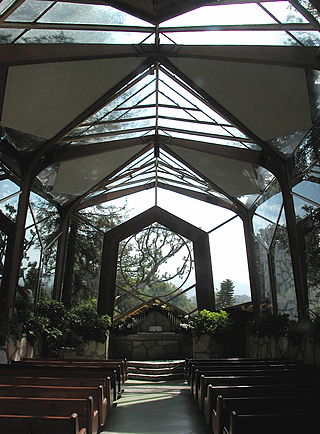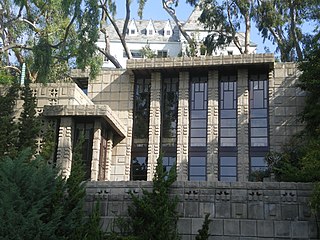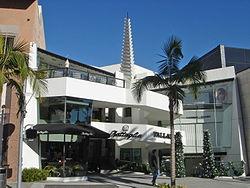
Frank Lloyd Wright Jr., commonly known as Lloyd Wright, was an American architect, active primarily in Los Angeles and Southern California. He was a landscape architect for various Los Angeles projects (1922–1924), provided the shells for the Hollywood Bowl (1926–1928), and produced the Swedenborg Memorial Chapel at Rancho Palos Verdes, California (1946–1971). His name is frequently confused with that of his more famous father, Frank Lloyd Wright.

Rodeo Drive is a two-mile-long (3.2 km) street in Beverly Hills, California, with its southern segment in the City of Los Angeles, known as one of the most expensive streets in the world. Its southern terminus is at Beverwil Drive, and its northern terminus is at its intersection with Sunset Boulevard in Beverly Hills. The name is most commonly used metonymically to refer to the three-block stretch of the street between Wilshire Boulevard and Little Santa Monica Boulevard.

The Ennis House is a residential dwelling in the Los Feliz neighborhood of Los Angeles, California, United States, south of Griffith Park. The home was designed by Frank Lloyd Wright for Charles and Mabel Ennis in 1923 and was built in 1924.

Wayfarers Chapel, or "The Glass Church" is a disassembled chapel designed by Lloyd Wright that was located in Rancho Palos Verdes, California. The chapel had unique organic architecture sited on a bluff above the Pacific Ocean. Affiliated with the Swedenborgian Church of North America, it served as a memorial to the 18th-century scientist and theosopher Emanuel Swedenborg. Originally constructed in 1949, the chapel was dismantled in 2024 and carefully stored due to extreme earth movement that made the site no longer suitable.

El Capitan Theatre is a fully restored movie palace at 6838 Hollywood Boulevard in the Hollywood neighborhood in Los Angeles, California, United States. The theater and adjacent Hollywood Masonic Temple are owned by The Walt Disney Company and serve as the venue for a majority of the Walt Disney Studios' film premieres.

Hollyhock House is a house museum at Barnsdall Art Park in the East Hollywood neighborhood of Los Angeles, California, United States. The house, designed by the architect Frank Lloyd Wright for the heiress Aline Barnsdall, is named for the hollyhocks used in its design. The main house, incorporating elements from multiple architectural styles, consists of three wings around a central courtyard. It was built alongside two guesthouses called Residence A and B, a garage building, the Schindler Terrace, and the Spring House. Rudolph Schindler, Richard Neutra, and Wright's son Lloyd Wright helped design the main house and the other buildings.

The Rosenbaum House is a single-family house designed by architect Frank Lloyd Wright and built for Stanley and Mildred Rosenbaum in Florence, Alabama. A noted example of his Usonian house concept, it is the only Wright building in Alabama, and is one of only 26 pre-World War II Usonian houses. Wright scholar John Sergeant called it "the purest example of the Usonian."

The Frank Lloyd Wright Home and Studio is a historic house and design studio in Oak Park, Illinois, which was designed and owned by architect Frank Lloyd Wright. First built in 1889 and added to over the years, the home and studio is furnished with original Wright-designed furniture and textiles. It has been restored by the Frank Lloyd Wright Preservation Trust to its appearance in 1909, the last year Wright lived there with his family. Here, Wright worked on his career and aesthetic in becoming one of the most influential architects of the 20th century.

The V. C. Morris Gift Shop is located at 140 Maiden Lane in downtown San Francisco, California, United States, and was designed by Frank Lloyd Wright in 1948. The store was used by Wright as a physical prototype, or proof of concept for the circular ramp at the Solomon R. Guggenheim Museum in New York City.

Storer House is a Frank Lloyd Wright house in the Hollywood Hills of Los Angeles built in 1923. The structure is noteworthy as one of the four Mayan Revival style textile-block houses built by Wright in the Los Angeles area from 1922 to 1924.

The Samuel Freeman House is a Frank Lloyd Wright house in the Hollywood Hills of Los Angeles, California built in 1923. The house was listed on the National Register of Historic Places in 1971. The house is also listed as California Historical Landmark #1011 and as Los Angeles Historic-Cultural Monument #247.

John Sowden House, also known as the "Jaws House" or the "Franklin House", is a residence built in 1926 in the Los Feliz section of Los Angeles, California by Lloyd Wright. The house is noted for its use of ornamented textile blocks and for its striking facade, resembling either a Mayan temple or the gaping open mouth of a great white shark.

Millard House, also known as La Miniatura, is a textile block house designed by Frank Lloyd Wright and built in 1923 in Pasadena, California. It was listed on the National Register of Historic Places in 1976.
Alan Hess is an American architect, author, lecturer and advocate for twentieth-century architectural preservation.
Norma Triangle is a residential neighborhood in West Hollywood, California. It encompasses the area bound by Doheny Drive and Beverly Hills on the west, Sunset Boulevard and Holloway Drive on the north, and Santa Monica Boulevard on the south. The small district has the shape of a right triangle.

The A. D. German Warehouse is a Frank Lloyd Wright designed Mayan Revival warehouse that was constructed in Richland Center, Wisconsin in 1921. Wright was born in Richland Center in 1867. The building is on the National Register of Historic Places.

The David and Gladys Wright House is a residence at 5212 East Exeter Boulevard in the Arcadia neighborhood of Phoenix, Arizona, United States. Designed by Frank Lloyd Wright in an organic style for his son David and daughter-in-law Gladys, it was built from 1950 to 1952. In the 2010s, the house was one of four remaining buildings designed by Frank Lloyd Wright in Phoenix and one of nine such buildings in Arizona. In addition to the main house, the site includes a small guesthouse to the northeast. It is listed on the National Register of Historic Places.

First Baptist Church of Ventura is a historic church at 101 S. Laurel Street in Ventura, California. It was built in 1926 and renovated extensively into the Mayan Revival style in 1932. Declared a landmark by the City of Ventura In 1975, the building was added to the National Register of Historic Places in 2009. Since 1952, it has been home to the Ventura Center for Spiritual Living.

7th Street is a street in Los Angeles, California running from S. Norton Ave in Mid-Wilshire through Downtown Los Angeles. It goes all the way to the eastern city limits at Indiana Ave., and the border between Boyle Heights, Los Angeles and East Los Angeles.





















